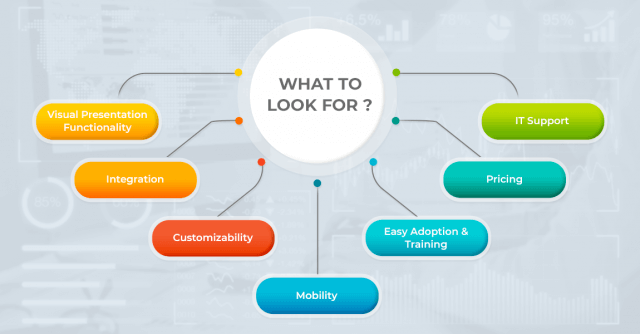Business Intelligence (BI) refers to the discovery and communication of insights or actionable information with the help of enterprise data. Analytics explores and propagates patterns and knowledge in data, which can be expressed through simple statistical tests or predictive systems powered by machine learning.
BI tools collect and process large amounts of unstructured data from internal and external systems, including portal, ServiceNow, databases like DynamoDB, SQL, Oracle etc, can be reported quickly using real-time reporting. They help prepare data for analysis and create reports, dashboards, and data visualizations helping both employees and the management. They can improve decision-making, enhance operational efficiency, explore new revenue potentials, identify and understand market trends, and report key performance indicators (KPIs).
BI and analytics tools are typically used for straightforward querying and reporting of business data and can combine a broad set of data analysis applications. They also use data visualization software for designing charts, as well as tools for building BI dashboards and performance scorecards that display business metrics and KPIs in easy-to-understand visuals.
An organization’s need for a sound BI infrastructure cannot be overlooked particularly with the accumulation of vast amounts of data that could be structured, semi-structured, and unstructured. Finding the right analytics platform will depend on the volume, variety, and quality of such data with the consideration of the existing IT infrastructure and technical abilities of available resources. It also depends on the overall business goal which is where finding the right solution followed by the right vendor comes into play.
Let us also not forget that data analytics is also constantly evolving to keep pace with advances in machine learning and artificial intelligence. The choice of the platform hence needs to be up to speed with the latest innovation, such as new ways to visualize and interact with data or deal with complex data structures.

According to Zion Market Research, the global business intelligence market is expected to grow at a CAGR of 8.6% during 2021-2028 and will reach $42.95 billion by 2028 from $22.16 billion in 2020,
With these many players in the segment, choosing the right solution is paramount, with a tactical approach to the buying process, setting the right goals, and finding the right ground to compare solutions.
Businesses must begin by evaluating internal requirements and aligning purchasing decisions with those goals. It’s also important to note that not all BI tools are the same and most companies do not hesitate to deploy multiple tools for different use cases, teams, or business units.
If you are an enterprise in search of an efficient BI tool, you should adopt a cloud-based tool that works on the virtual and web-based data warehouses. It should facilitate multi-source data connectivity and self-driven reporting tools. Predictive analytics and data forecasting features are also important. In addition, AI/ML-enabled tools can help you unlock maximum value from data.
As a global SAP partner, Gemini Consulting and Services can help you make better, faster and data-driven decisions using BI tools. Contact us to know the advantages of SAC and customize it to meet your business requirements.

Strategy to Select BI Tools for Your Organization
- Visual Presentation Functionality: The tool that helps create data visualizations must support a variety of user types. It also must allow for the level of customization and flexibility that supports business objectives and the requirements of the various functional groups in the organization. The business intelligence reporting tool is the face of the business. Hence struggling with dashboards that are difficult to create or to understand or feature poor-quality visuals will deter users from embracing and working with the tool.
- Integration: While a standalone solution can only be accessed and viewed in its application; an integrated solution can be accessed and viewed through various pre-existing applications, websites, and services within the business. Integration puts the benefits of BI directly into a service that business users already use and are familiar with.
- Customizability: The BI vendor must be able to build a solution that fits every business’ data requirement. The solution needs to be flexible to accommodate future needs and changes in objectives. By and large, most businesses will need a custom set-up –one that can integrate flawlessly into their operations and grow as they grow. Business users on the other hand can be very particular about how they consume their data, thereby making customization and extensibility critical factors that influence the purchase of a BI tool/vendor.
- Mobility: Mobility features are crucial to factor in for businesses that function with off-site workers, board members, or stakeholders who need access to company data to be effective and informed. It is therefore important to assess what is expected out of the mobile BI application. The kind of features needed on the go and whatever else that is needed to ensure the success of working with one.
- Easy Adoption & Training: Product training is a necessary investment to reap the full benefits of any BI solution. BI can radically change businesses for the better, provided time is taken to give quality and flexible training to users on the BI product. Now, this must be assured by the BI vendor or the business must seek to expand resources for this training to be accommodated.
- Pricing: There are three major things to consider such as subscriptions, growth, and hidden fees. It is also important to understand and obtain complete details of quarterly or yearly subscriptions on top of any upfront costs. Evaluate scaling up solutions with a flexible pricing model, additional fees that aren’t listed in the pricing model, but are necessary for full implementation upfront to avoid any surprises in the future.
- IT Support: A self-service BI tool allows business users an easy BI experience; freeing up IT resources to focus on other tasks. What is ideal with self-service capabilities is that it still allows for IT to easily control the deployment and prevent user chaos later. This said it is necessary to ensure that the vendor also has a fully capable support team to accommodate any issues or questions technical users may have. Narrowing down on an expert, flexible vendor who can provide solutions customized to the organization’s needs or problems will make a difference to any organization’s entire BI experience.



